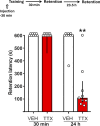Intense training prevents the amnestic effect of inactivation of dorsomedial striatum and induces high resistance to extinction
- PMID: 38843228
- PMCID: PMC11156383
- DOI: 10.1371/journal.pone.0305066
Intense training prevents the amnestic effect of inactivation of dorsomedial striatum and induces high resistance to extinction
Abstract
A large body of evidence has shown that treatments that interfere with memory consolidation become ineffective when animals are subjected to an intense learning experience; this effect has been observed after systemic and local administration of amnestic drugs into several brain areas, including the striatum. However, the effects of amnestic treatments on the process of extinction after intense training have not been studied. Previous research demonstrated increased spinogenesis in the dorsomedial striatum, but not in the dorsolateral striatum after intense training, indicating that the dorsomedial striatum is involved in the protective effect of intense training. To investigate this issue, male Wistar rats, previously trained with low, moderate, or high levels of foot shock, were used to study the effect of tetrodotoxin inactivation of dorsomedial striatum on memory consolidation and subsequent extinction of inhibitory avoidance. Performance of the task was evaluated during seven extinction sessions. Tetrodotoxin produced a marked deficit of memory consolidation of inhibitory avoidance trained with low and moderate intensities of foot shock, but normal consolidation occurred when a relatively high foot shock was used. The protective effect of intense training was long-lasting, as evidenced by the high resistance to extinction exhibited throughout the extinction sessions. We discuss the possibility that increased dendritic spinogenesis in dorsomedial striatum may underly this protective effect, and how this mechanism may be related to the resilient memory typical of post-traumatic stress disorder (PTSD).
Copyright: © 2024 Martínez-Degollado et al. This is an open access article distributed under the terms of the Creative Commons Attribution License, which permits unrestricted use, distribution, and reproduction in any medium, provided the original author and source are credited.
Conflict of interest statement
The authors have declared that no competing interests exist.
Figures







Similar articles
-
Protein synthesis is not required for acquisition, consolidation, and extinction of high foot-shock active avoidance training.Behav Brain Res. 2015;287:8-14. doi: 10.1016/j.bbr.2015.03.031. Epub 2015 Mar 23. Behav Brain Res. 2015. PMID: 25813750
-
Intense aversive training protects memory from the amnestic effects of hippocampal inactivation.Hippocampus. 2014 Jan;24(1):102-12. doi: 10.1002/hipo.22210. Epub 2013 Nov 1. Hippocampus. 2014. PMID: 24123595
-
Differential Arc protein expression in dorsal and ventral striatum after moderate and intense inhibitory avoidance training.Neurobiol Learn Mem. 2017 Apr;140:17-26. doi: 10.1016/j.nlm.2017.02.001. Epub 2017 Feb 6. Neurobiol Learn Mem. 2017. PMID: 28185871
-
Involvement of kinases in memory consolidation of inhibitory avoidance training.Rev Neurosci. 2024 Sep 27;36(2):189-208. doi: 10.1515/revneuro-2024-0093. Print 2025 Feb 25. Rev Neurosci. 2024. PMID: 39323086 Review.
-
Effects of Cannabinoid Drugs on Aversive or Rewarding Drug-Associated Memory Extinction and Reconsolidation.Neuroscience. 2018 Feb 1;370:62-80. doi: 10.1016/j.neuroscience.2017.07.018. Epub 2017 Jul 17. Neuroscience. 2018. PMID: 28729064 Review.
References
MeSH terms
Substances
LinkOut - more resources
Full Text Sources

